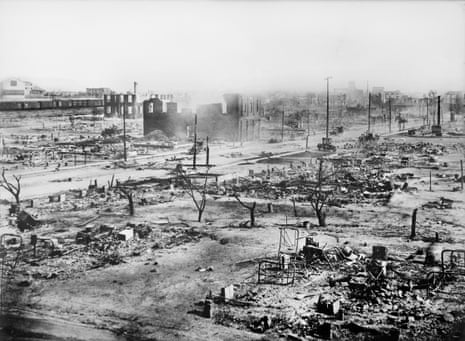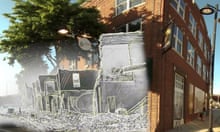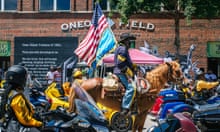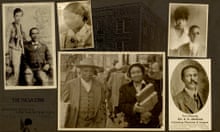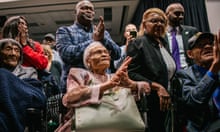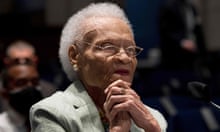There was no memorial to it in town. Teachers made no mention of it, not even during a half-semester devoted to local history. The white schoolboy Scott Ellsworth of Tulsa, Oklahoma, was left to wonder what the city’s darkest secret could be.
“As a 10- and 11-year-old, I would occasionally hear older adults, neighbours, talking about what we then called ‘the riot’ and they would always lower their voices or change the subject,” recalls Ellsworth, now 67. “I started to catch wind of these stories about bodies floating down the Arkansas River, machine guns on the roofs of town, but you couldn’t really find out anything about it.”
All that changed one day in 1966 when the local library installed a microfilm reader and Ellsworth and friends fed in daily newspapers from 1921. “We were just gobsmacked: hundreds die, martial law declared,” says the author and historian. “We weren’t sophisticated enough to put it all together but I knew at that point that the skeleton in the closet was true.”
The truth that could no longer be denied was that, on 31 May and 1 June 1921, a white mob had attacked Tulsa’s Black Wall Street, killing an estimated 300 people and wounding 800 more while robbing and burning businesses, homes and churches. Planes dropped explosives on the area, razing it to the ground. It remains one of the worst acts of racial violence in American history.
Tulsa is now preparing to mark the centenary of the bloodshed in its Greenwood neighbourhood with a commemoration featuring Joe Biden, a candlelight vigil, the unveiling of a history centre, the Tulsa Juneteenth festival and other events and performances.
But it took years of dogged research by Ellsworth to help start the city on a journey to end its culture of silence and confront its racist past. He was studying history at a college in Portland, Oregon, when he decided to make the massacre the subject of his senior thesis. He returned to Tulsa in the summer of 1975 but found it difficult to penetrate the taboo.
“Records were missing, they were destroyed,” he says by phone from Ann Arbor, where he teaches at the University of Michigan. “Clerks would kind of blow me off in offices and I just couldn’t put this together at all. It was almost impossible to find any photographs but I did see one of Greenwood after the massacre and it just looked like Nagasaki or Hiroshima or Frankfurt, just totally everything gone.”
Ellsworth made a breakthrough when he came across a collection of city directories – precursors of telephone books listing the names of every individual and business. “I noticed that after about every 10th name, there was a lower case ‘c’ in parentheses. I realised, oh, that meant ‘coloured’, so this is a listing of all the African American people and businesses.
“I’d been really interested in trying to understand what the Greenwood business community looked like. So I went to the city engineer’s office and got these ‘plat’ maps that I taped together and then I went through these city directories and I wrote down every single address and what the business was, what person lived there. The business community then became alive to me. It just wasn’t statistics.”
Eventually Ellsworth tracked down William D Williams, an African American retired teacher who had been 16 when the massacre happened. “I drive to his house and sit down and I’m explaining who I am and he’s kind of cool to me. I’m thinking, ‘This interview is going nowhere, I should try to figure out where to end it,’ and politely get out.

“Then I remembered my map and we spread it out on his kitchen table and all of a sudden he’s just entranced, he’s poring over this thing, he’s moving his finger from address to address to address, and he’s smiling and shaking his head. What I had created was a map of his youth and there were names he hadn’t thought about in 70 years.
“Then all of a sudden he looks up and says, ‘OK, tell me what you want to know’. I thought it was going to be an hour interview; we talked for four hours and it was the moment. He was the one, he was at all the right places in the right time and really it’s because of him that we were able to save the history of what happened.”
Ellsworth adds: “I was honoured because Mr Williams had been waiting all of his life to tell this story. He was waiting for a journalist, a TV crew, a professor. He sure as hell wasn’t waiting for a 21-year-old white kid from the side of town that the people had come to murder him and his family. I give him great credit for taking a chance on talking to me.”
Three years later, Ellsworth returned to Tulsa again to turn his thesis into a book. Williams connected him with other elderly African American survivors who told their stories for the first time. The author formed a deep bond with them.
“They had never been interviewed before. They didn’t talk about the massacre in their own family. I ended up being their witness. It didn’t have to be me. It could have been you or somebody else. It just happened to be me. That was one of the highest professional moments of my life.”
Conversely, Ellsworth found it almost impossible to get any white person to admit they had been involved in the carnage (none faced criminal charges). On one occasion he visited a white police officer who was happy to talk about his career but became taciturn when the subject came up.
“He had a scrapbook of photographs of him in uniform and whatnot. This is the pre-digital era so I’ve borrowed a 35mm camera and I’m taking photos of them and all of a sudden I turn a page and it’s all riot photographs. I’m so excited because I haven’t seen it and he grabs the book and says, ‘No, you can’t take pictures.’ People just didn’t want to talk about it at all. It’s like families of German soldiers: who wants to talk about this?”
When Ellsworth’s Death in a Promised Land – the first comprehensive history of the massacre – was published in 1982, the survivors threw a launch party but the book was mostly ignored by the local white media. However, the author notes: “For a number of years it was the most stolen book out of the Tulsa City county library system. They’d even steal the branch copies. So once a year, I just sent them a box of books.”
Tulsa’s secret was out and could not be forgotten again. The massacre’s 75th anniversary in 1996 received national media attention. The Tulsa Race Riot Commission was formed a year later to carry out a long overdue investigation and make the case for reparations.
Ellsworth started a search for the unmarked mass graves of victims but it stalled in 2000 due to political wrangling. The effort resumed at the request of the city mayor in 2019. With a combination of hard work and luck, 12 fragile pine coffins and remains were found last October in what had been the city’s most important cemetery at the time of the massacre.
“Obviously, I was thrilled. This had been a 20-plus-year search but the reality is sad and deadening when you think of these people. But in all honesty, I thought back about WD Williams and those other survivors who had really led me on this story and I thought about how happy they would be. I really thought of them.”
The mass grave at Oaklawn cemetery will be exhumed on the hundredth anniversary. It will be one more step towards Tulsa’s reckoning with itself. But it will not necessarily bring peace and reconciliation to a city that remains deeply segregated along racial lines.
“The story of the massacre was actively suppressed in the white community for 50 years,” reflects Ellsworth, who returns to the subject in a new book, The Ground Breaking: An American City and Its Search for Justice, published by Dutton Books in the US and Icon Books in the UK. “Researchers had their lives threatened, their jobs threatened.
“Some people don’t want to talk about this at all; they just want to cover it back up. Others are shameful about it. Others are heartbroken. You had whole generations of people who grew up in Tulsa not knowing about it and now to learn about it, that’s caused some stress.”
But there was also widespread silence in the African American community for nearly half a century, he adds. “A number of the survivors suffered PTSD all their lives. Others, like Holocaust survivors, didn’t really want to burden their children with these stories. So there were descendants who were my age that didn’t learn about the fact that their grandparents had lost their home and their business until they were in their 40s. They didn’t talk about it.”
